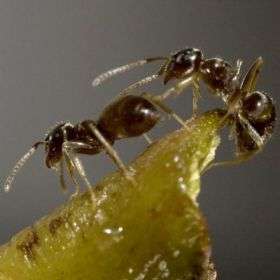Attack of the invasive garden ants

An ant that is native to Eurasia is threatening to become the latest in a procession of species to invade Europe, as a result of inadvertent human introduction. Research published in the online open access journal BMC Biology demonstrates that the invasive garden ant, Lasius neglectus, which is a threat to native species, may already be more widely established than expected.
Sylvia Cremer is from the University of Copenhagen in Denmark and the University of Regensburg in Germany. Working with colleagues from these institutes and the University of Keele in the UK, she looked at colonies of ants in 14 locations around Europe.
Using a combination of genetic, chemical and behavioural analyses, the researchers investigated the similarities between colonies to reconstruct the route of invasion and dispersal strategy of this pest ant. They established that the invading populations arose from only a handful of introductions to Europe and that infested sites are effective originators for new introductions.
Dr Cremer explained what the results imply: “Many more infestations of the garden ant are likely to have taken place already, but have remained undiscovered due to the usual lag phase for invasive species to become established.”
The native range of invasive garden ants is unknown, but is thought to be in the Black Sea region. One hundred populations are already known in Europe. The ants can survive mean winter temperatures of -5°C, so their range could eventually extend from Scotland to Japan.
Invasive garden ants are found in urban environments such as parks and gardens, rather than natural habitats. They are often very aggressive to native species, killing off indigenous insects and spiders.
Dr Cremer stated: “We hope that our present study will contribute to establish greater awareness of this pest ant, so that new infestations can be exterminated before they become damaging.”
Citation: The introduction history of invasive garden ants in Europe: integrating genetic, chemical and behavioural approaches, Line V. Ugelvig, Falko P. Drijfhout, Daniel J.C. Kronauer, Jacobus J. Boomsma, Jes S. Pedersen, Sylvia Cremer, BMC Biology (in press)
Source: BioMed Central

















